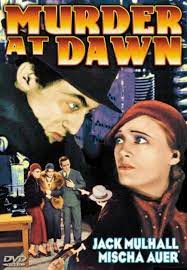
Doris Farrington (Josephine Dunn) and Danny (Jack Mulhall) are planning to be married. Their witnesses are their best friends Gertrude (Marjorie Beebe) and Freddie (Eddie Boland). They plan on first making a quick stop at Doris’ father’s mountain estate to ask for his permission to marry. Dr. Farrington (Frank Ball) is an inventor who is working on a solar energy source that will provide limitless, inexpensive energy. He keeps a laboratory in his country house where he has been perfecting his invention. The only other people in the rambling house are Farrington’s creepy housekeeper (Martha Mattox) and her son, the even creepier groundskeeper, Henry (Mischa Auer).
When they arrive at the train station the two couples rent a driver (George Reed) to take them out to the house. The mansion has a reputation of being haunted. After dropping them off the driver refuses to stay. While the couples are making their way to the front door, Farrington has been discussing his invention with one of his backers, Judge Folger (Phillips Smalley). The judge plans on calling a meeting to announce the completion of the device. Just then Farrington is attacked and the judge is murdered. Doris enters and sees her father hurt. She runs back out to get help. When they return Farrington is gone.
Beside the sinister household staff, prowling around the grounds, are two strange men peeking into windows and listening in on conversations. Doris and Danny try to find her father, but someone is determined to get Farrington’s formula and will stop at nothing to do so.
“Murder at Dawn” AKA “The Death Ray” in Britain, was released in 1932 and was directed by Richard Thorpe. It is a rather creaky pre-code low budget old dark house murder mystery. The movie is said to have been sixty-two minutes long but the only prints I’ve ever seen were no more than fifty-one or fifty-two minutes long. Some ten or eleven minutes are missing from the original film.
Although the film title in Britain was changed to “The Death Ray” the movie doesn’t really have a death ray in it. The invention is a power generator. In fact the gizmos used in the movie as the generator are actually Kenneth Strickfaden’s wonderful wiz bangs. This is the first film where Strickfaden’s machines were used after “Frankenstein” 1931. Unfortunately they are only shown briefly.
On the plus side, the movie is full of old dark house elements. There is the spooky house out in the country, thunder, hidden rooms and passages, faces peering into windows, and a decent eerie atmosphere.
On the minus side, because of the missing eleven minutes there are some continuity issues with the movie. There are two men lurking around the house. One, I believe is a spy trying to get information on the device and the other was hired by the Judge, he might even be an insurance investigator, to find the spy. Neither one is introduced so I don’t know which one is Arnstein and which one is Goddard. Of course, there are also issues with the quality of the print and the editing.
Another drawback is the racist portrayal of a black taxi driver played by George Reed. As for Freddie, the comic relief, I just don’t find alcoholism funny, especially of the drunken slapstick humor type.

